Free Lawn Care Guides
These guides are free to use and share. No apps to download, no email signups, nothing. We leave these websites up 365 days a year for use them all you want.
#1 Pick Your Grass Type
Bermuda → HERE
Zoysia → HERE
Cool Season (Fescue, KBG, Perennial Rye) the info is located below / on this website
Before you begin…
#1 You can change the font size and background color by clicking the wheelchair ICON.

Cool Season Lawn Care Products
Printable Calendar → HERE
Parts of the Grass Plant
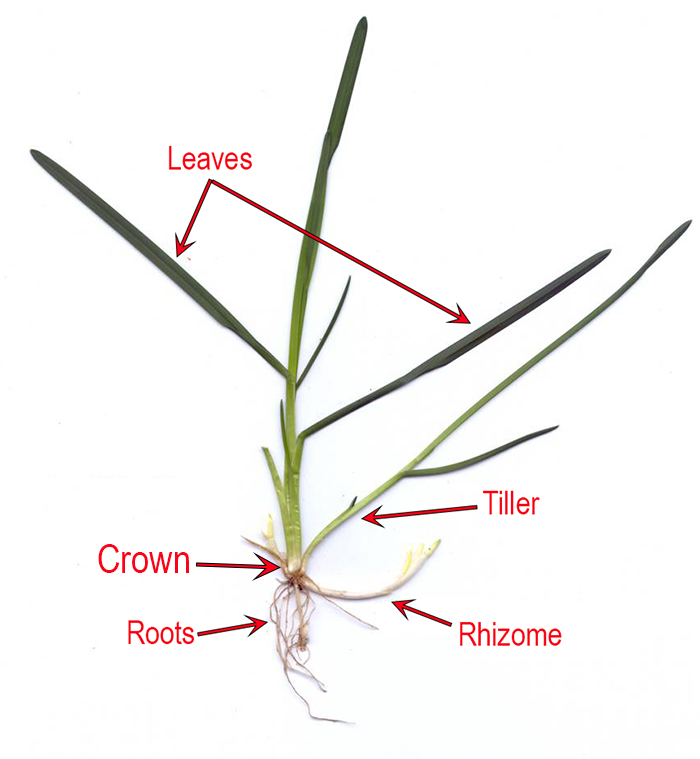
Where to Plant – Zones
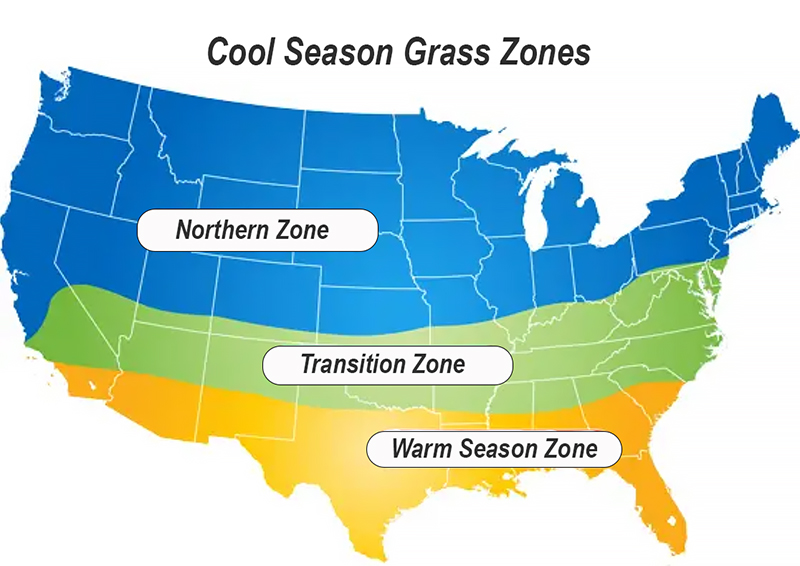
TYPES of Cool Season Grasses
Fescue, Rye, and Kentucky Blue Grass (KBG). Within these types of grasses there are MANY varieties, and it can get confusing. So, we will first focus on the basics. Fescue – A non-spreading grass that grows in clumps. These “clumps” spread out slightly via tillers until the lawn is full. (see above) Fescue is the most common cool season grass in the US. Mostly planted from seed, it also comes in sod. The general cutting length is 2.5 to 4 inches and has good drought and traffic resistance. Most fescue has a flat, slightly wider grass blade.It likes full sun but there are varieties that are slightly more shade tolerant. It’s easy care, traffic tolerance and drought tolerance make it one of the easiest cool season lawns to care for. Like the name implies, fine fescues have a very fine blade and look “soft”. While this look may be desirable, we generally don’t recommend them for lawns. They can be used in shady areas, as many varieties are more shade tolerant. They generally are less drought and wear tolerant and not as “dark green” in color. Most fine fescues do NOT do well in hot, sunny areas. This isn’t a “rule” but rather a suggestion. If you want a softer and shorter lawn, then consider a Rye or KBG. Perennial Rye Grass A non-spreading grass that grows in clumps. These clumps spread out slightly via tillers until the lawn is full. (see pic above) Perennial Rye Grass is usually planted via seed, but also comes in sod. Cutting height is usually 1.5 to 2.5 inches. It also comes in “sod grade” premium seed, which can be cut very low, down to 1/2 inch via reel mower. There are MANY varieties with various textures, colors, and benefits. Perennial ryegrass has a fine to medium leaf texture and tends to be dark green. It germinates rapidly and is quick to establish, making it suitable for overseeding. It may be competitive with other grasses, however, and so is sometimes used either alone or in combinations of about 20% perennial ryegrass mixtures with Kentucky bluegrass or fine fescues. It is wear and heat tolerant but will not withstand shade and drought well. Kentucky Blue Grass – (KBG) KBG is one of the few cool season grasses that spreads both via tillers and rhizomes. (see pic above) It can be seeded or put down via sod. The average homeowner will cut between 2-3 inches but for those that want a really short cool season lawn, there are high quality, “sod grade”, premium seeds. This type of KBG can be cut down as low as 1/4″ with a reel mower. There are MANY grades, types, and all vary in texture and color. Tolerance is high for cold and wear, and moderate for heat and drought. The grass becomes semi-dormant during extended hot and dry conditions. It will recover quickly in cooler temperatures and moisture provided the drought was not severe. Kentucky bluegrass is best grown in well drained, sunny areas. It requires a higher amount of N fertilizer (2-4 lb. N/1000 sq.ft. per growing season) than other cool season lawn grasses and may produce a significant amount of thatch.
Fine Fescue vs. Tall Fescue
Mixing Grass Types
Most Important Step
Soil Testing
On that page Doc goes over what is important and what to focus on. He also walks you through the testing process and how to ship them off. Doc also talks about not “reading too much” into your soil test. He mainly looks for wild spikes and PH levels.
Soil PH
Why does this matter? When PH levels start to get too high or too low certain nutrients can either get locked up in the soil, or be depleted easily. (See the chart below.)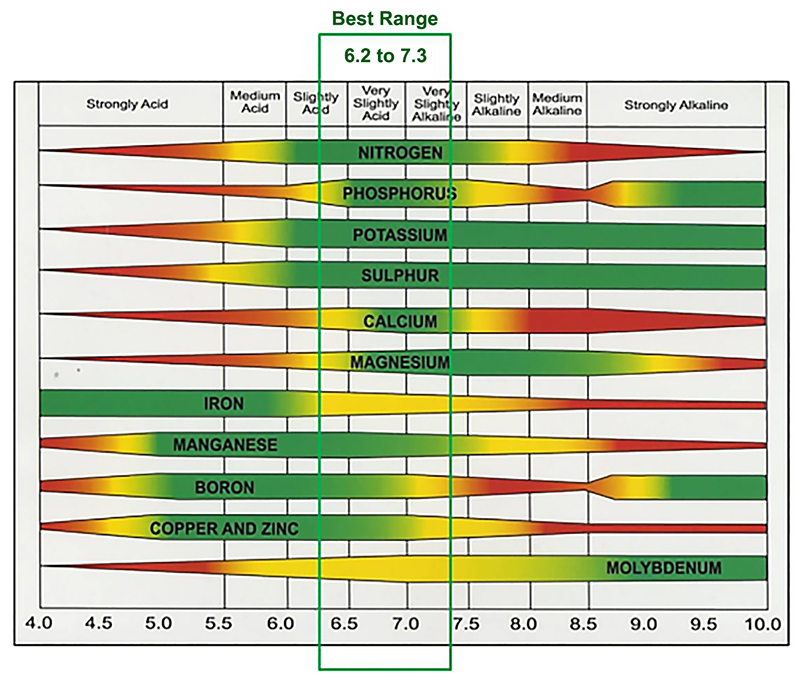
Raising Soil PH
Lowering PH
Understanding Lawn PH Video
Doc covers the PH issue.
PH video
Measure Lawn SQ / FT
Why do we stress HUMICHAR?
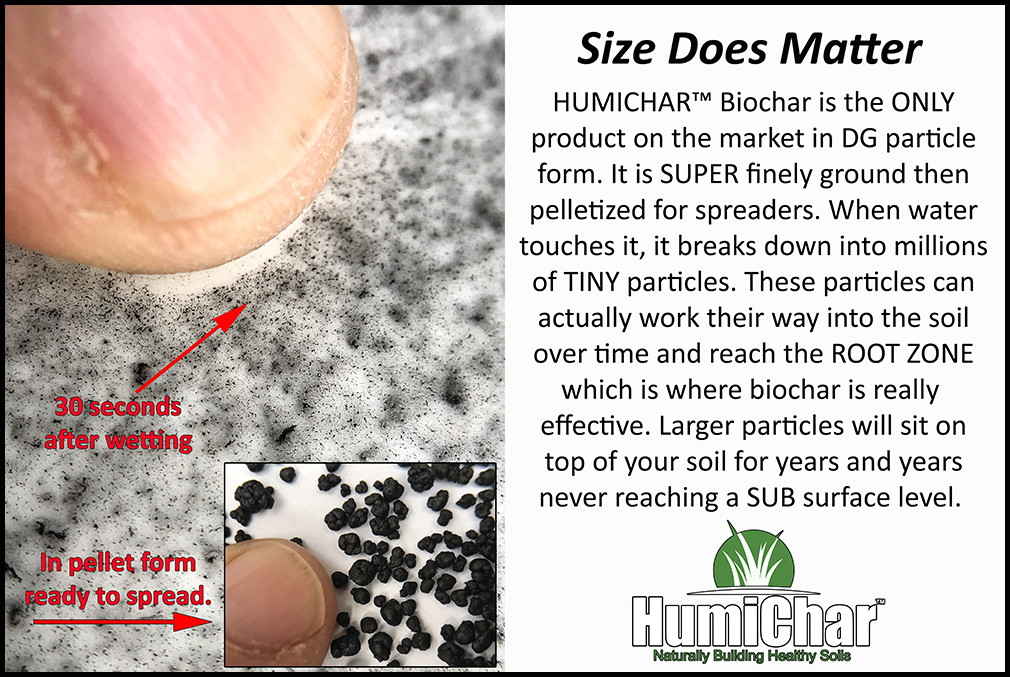
Your Soil Sucks…
Adding Organic Matter
Soil microbes are GOOD… mycorrhizal fungi in soils are GREAT for lawns. Both play critical roles in the health of your lawn. However, both need quality ORGANIC matter to survive. This is why we created DIRT BOOSTER. DirtBooster can be applied to your lawn in a spreader, then spray it with the microbe and fungus booster pack which is included. Do this when temps are warmer, above 80 degrees, and do this as often as you want. The video below explains the benefits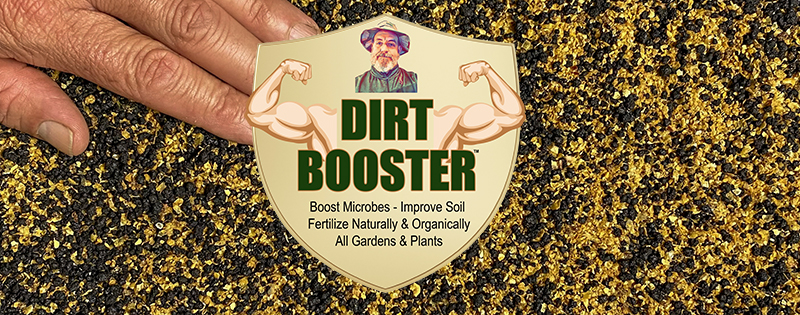
Cool Season Lawn Fertilizers
Organic lawn fertilizers either contain waste products or plant based products such as soybean. Both of these must be BROKEN DOWN via microbe / fungus decomposition before nutrients are released. (Just spreading them on your lawn will NOT add nutrients) This “break down” process only occurs rapidly in warmer temps. However this goes AGAINST our target fertilization times which is usually in the cooler weather. Therefore, we prefer STANDARD type, direct nutrient fertilizers like → PGF Complete. Chemical fertilizers do NOT rely on temperature, microbes, or fungus to start working. Organics can be used effectively in the warmer months, but by then we generally “tone back” our feeding of cool season lawns.
Which Fertilizer “Numbers” to Use
Example statements from Unv Ext offices… “In most cases, a rate of one pound of nitrogen per 1,000 square feet is suggested for each fertilizer application to the lawn. If high percentage nitrogen fertilizers are used, then less actual fertilizer product is needed to supply that one pound compared to fertilizers with low percent nitrogen. Recommended ratios of N-P-K for lawn fertilizers include 3:1:2 or 4:1:2” → Link to Citation “Good maintenance type fertilizers should be in a 3-1-2 ratio of nitrogen (N) to phosphorus (P) to potassium (K). An example of a 3-1-2 ratio fertilizer would be a 15-5-10 or something relatively close to this.” → Link to Citation “If you have not had a soil test, apply a fertilizer that is four to six parts nitrogen, one part phosphorus and two to four parts potassium. A 16-4-8 fertilizer analysis would fall within this range with a 4-1-2 ratio of these nutrients.” → Link to Citation “Use a 3-1-2 or 4-1-2 ratio fertilizer if you elect not to conduct a soil test. A common example of a 3-1-2 ratio fertilizer is 15-5-10,while a good 4-1-2 ratio fertilizer is 16-4-8.These ratios generally supply what most lawns need, and they won’t dramatically increase the phosphorus levels if it’s unneeded” → Link to Citation
When do we vary these numbers?
1- A soil test shows an EXCESS or DEFICIENCY of a nutrient. When that shows we need to adjust our numbers. At that point we may use something like → PGF Balance to increase low phosphorus as an example. 2- We are either in a period of GREEN UP, (late spring) higher nitrogen requirements, or a slow growth period, (late fall) lower number of nitrogen requirements.
Fertilizer Myths
Myth #2 – “Adding a LOT of “X” nutrient will help roots grow.” A plant only requires a certain amount of a nutrient to grow at its peak potential. As an example… using a scale of 1-10, if a plant requires a “5 out of 10” of potassium for best root growth, adding MORE potassium above this amount will NOT increase root growth. In other words, adding excess of a nutrient will not generate a “better” response. In fact it can have negative impacts. That’s why lawns with HIGH phosphorus need to be adjusted because high phosphorus can LOCK UP nutrients in the soil.
Understanding Supplements
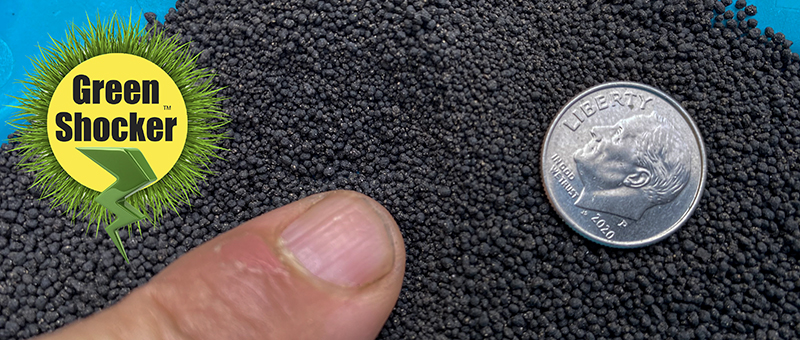
Summer Fertilizing
Pay Close Attention…
What is spoon feeding?
If you have a cool season lawn, you’re not in a drought, have irrigation, or have several days of rain approaching, you can do a spoon feeding. Keep in mind you also should not have recently applied strong long-term applications either. You can spoon feed your lawn with Super Juice or GreenShocker.
Aeration of Lawns
Aeration will work better / be easier if the lawn is cut fairly short. It’s HARD to pick up plugs on a cool season grass unless the grass is cut very low. However, we prefer to pick them as explained in the video below.
De-thatching Your Cool Season Lawn
Dethatching can be done as part of a late winter / early spring cleanup or done during the growing season.
Bugs and Grubs
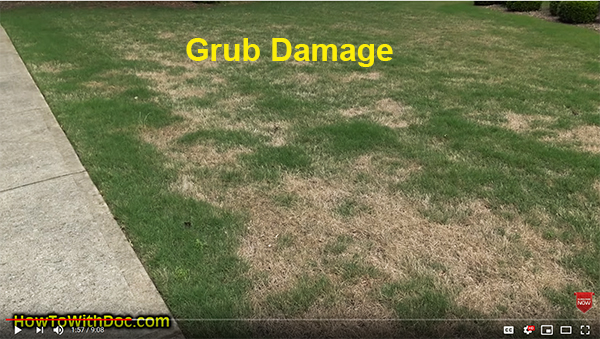
This could be an endless subject addressing 100s of “pest problems”, however we are going to keep it simple. The two most common lawn damage pests are white grubs and armyworms.
Grubs eat the ROOTS of the lawn causing medium to large brown patches in the lawn. Armyworms eat the blades of grass. Beetles form the grubs, and moths lay the armyworm eggs.
The simplest way to handle these two pests is to do a treatment twice a year. Once in the late spring and once in the late summer / early fall. We treat them with the → “doucide granules” which are spread on the lawn and then watered in.
If your armyworm problem is BIG… you can also spray your lawn with a HOSE END, over the counter lawn pest spray like this one. → Bayer Spray
Fungus and Disease
If you want pictures to help you ID your disease look → HERE We like to apply the → granular fungicide in the spring as the weather warms up as a preventative. However, sprays may also be required to TREAT active problems and can be bought at lost “big box” stores. 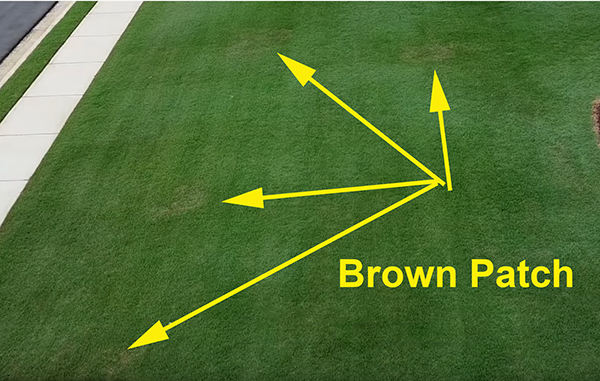
Leveling Your Lawn
This must be done during the active growing season. When leveling it’s critical to understand that we are leveling the GROUND / soil and not the grass. So, grass must be cut as short as possible without damaging it. If you level your lawn with LONG grass, the leveling mix not evenly lay on the ground and it will CLUMP causing a mess.
Rolling your lawn?
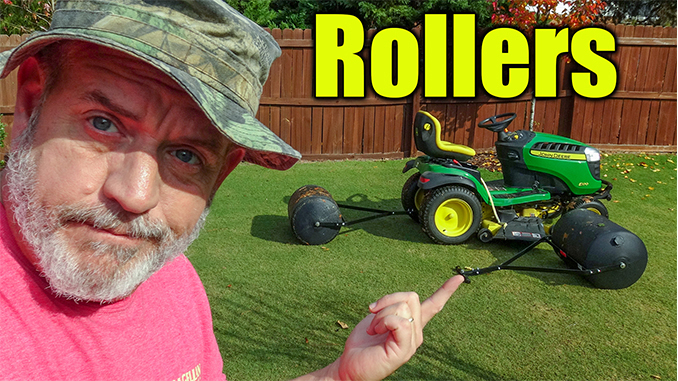
We have tested consumer grade rollers you fill with water or sand. In all cases we have found that the pressure / sq inch of these rollers is insufficient to make much of an improvement (if any). Also, the soil must be VERY wet to move at all. We say don’t bother. There are commercial companies that will come roll northern lawns with small “pavement rollers”. This can be very effective in lawns that suffer from frost heave. NOTE: if you do decide to get a roller and fill it with sand, you may not be able to use it due to the weight.
Cool Season Lawn Mowers
How Often to Cut
Watering Your Lawn
This is NOT the case for newer lawns with shallow roots, especially during a drought period. Newly sodded lawns and newly seeded lawns may need short waterings 2 -3 time a day for the first few weeks, then every other day once newly established, then 3-4 times a week during the heat. Doc discusses short watering vs. long water cycles in this video. Many lawns will also have “hot spots”. These are areas where below the surface something is causing the lawn to dry out FAST. In our yards tree roots and construction debris areas dry out 5 times fast than the rest of the yard. We often have to hand water these spots during hot weather.
Killing Weeds
Seeding Your Lawn
Cool season seeds like to be planted shallow. They should be planted anywhere from 1/8″ to 1/2″ in the soil. Doc likes to scarify the lawn after the seed has been spread out. Watch the video below.
Season By Season Care
Winter – Your lawn is “asleep” / dormant and nothing really to do at this point. If you don’t have snow on the ground THIS… is the time to make heavy PH adjustments and add carbon to your soil with → HUMICHAR Carbon takes a LONG time to work into the soil depths so starting now will have it deeper in the soil when we start the spring care. Late Winter / Very Early Spring This is the time to apply pre-emergent to your established lawn. It’s better to have the pre-emergent down 2 weeks before your recommended or “target date” which is determined by your soil temp. Most will say a soil temp of 51 – 53 degrees is when you apply. → SOIL TEMP MAP Next, start the jump start program. Your soil has been sitting all winter long with nothing done to it. Many nutrients have been leeching out and soil microbes and good fungus are pretty much nonexistent. We call this the “post winter wasteland”. We want our grass to WAKE UP into a healthy environment without HEAVY levels of nitrogen. So, about the time you put down your pre-emergent, put down a coat of → PGF BALANCE. This is a VERY fine particle, 10-10-10, all fast release fertilizer for lawns. This will inject your soil with a mild level of nutrients for when it first wakes up. Clean up of dead leaves and yard waste starts to happen. Early Spring – Time to cut the dead grass off the lawn. Take it LOW and remove all the dead brown grass. Bag it up and remove it from the lawn. Next, if you have a heavy thatch layer, you may want to consider a light dethatching as well. As temps start to rise and green haze starts to cover your entire lawn, it’s time to put down your main feeding / base fertilizer, PGF Complete. Spring – Overseeding can be done with the understanding that as summer approaches this may require heavier irrigation than the established grass. Grub killer can be applied as well as curative or preventative fungicides. Dethatching, aeration, and leveling may also be started once the grass is growing and healthy. Once daytime temps reach high 70’s organic treatments like Dirt Booster may be applied. Summer – Watch for diseases and treat. Strong, slow release, base fertilizers should NOT be applied at this time. Instead switch of to LIGHT supplemental feedings with products like Green Shocker or Super Juice. Cutting height is usually increased up 1/2 to 1″ taller than the spring cut. Lawn should NOT be allowed to totally dry out for extended periods or it may turn brown and go summer dormant. Late Summer / Early Fall – Watch for armyworms and treat for grubs. GreenShocker may be used until temps fall into the high 70s. At that point you can switch back to a slow release PGF Complete. Cutting height can be brought back down to normal height. Aeration and seeding usually takes place at this time. Do NOT apply any pre-emergents if you plan to seed. Fall into Late Fall – Your slow release fertilizer application should hold you through this period. If you want to add more, use a fast release fertilizer like Green Shocker. As the colder weather approaches, and grass slows it’s growth, put out a light coat of PGF Balance 10-10-10. This will be your last treatment of the fall going into winter. As temps REALLY start to drop,winter is approaching, and growth totally stops, you can apply your winter pre-emergent.
